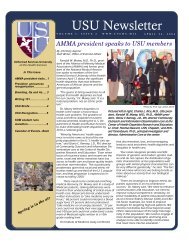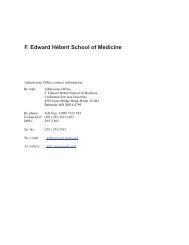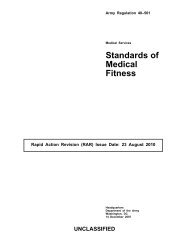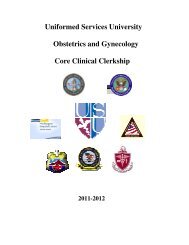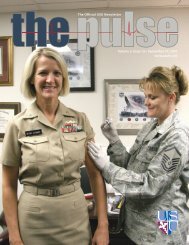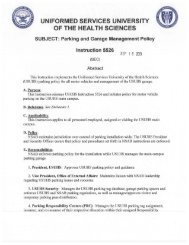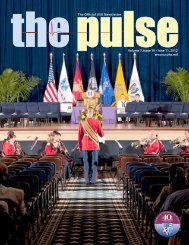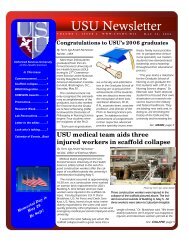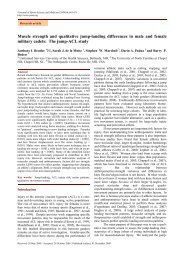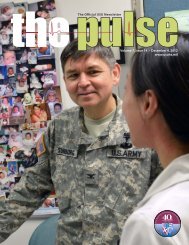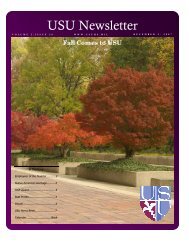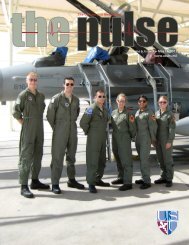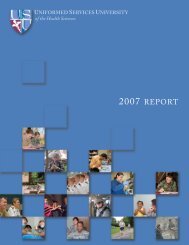2012 Annual Report - Uniformed Services University of the Health ...
2012 Annual Report - Uniformed Services University of the Health ...
2012 Annual Report - Uniformed Services University of the Health ...
You also want an ePaper? Increase the reach of your titles
YUMPU automatically turns print PDFs into web optimized ePapers that Google loves.
<strong>Uniformed</strong> <strong>Services</strong> <strong>University</strong> <strong>of</strong> <strong>the</strong> <strong>Health</strong> Sciences<br />
Center for Neuroscience<br />
And Regenerative Medicine<br />
results, including <strong>the</strong> National Institutes<br />
<strong>of</strong> <strong>Health</strong>. The CNRM recently<br />
partnered with NIH to purchase a<br />
high-tech, full-body scanner with<br />
unique, cutting-edge features. The<br />
Biograph mMR takes positron emission<br />
topography and magnetic resonance<br />
imaging simultaneously, which makes<br />
patient care swifter, safer and more<br />
comprehensive, since it provides a more<br />
complete picture <strong>of</strong> metabolic activity<br />
in a shorter time frame than separate<br />
MRI and PET scans.<br />
America has been at war for more than<br />
a decade now, and thousands <strong>of</strong> servicemembers<br />
have been wounded during<br />
this time. Traumatic brain injuries,<br />
however, have been some <strong>of</strong> <strong>the</strong> most<br />
prevalent wounds <strong>of</strong> Operation Iraqi<br />
and Enduring Freedom.<br />
More than 200,000 servicemembers<br />
have been affected by TBIs worldwide.<br />
These injuries are hard to diagnose<br />
and treat. They also seem to affect each<br />
person differently, making <strong>the</strong> science<br />
to understand <strong>the</strong>m a very difficult<br />
and slow-moving field. But, <strong>the</strong> Center<br />
for Neuroscience and Regenerative<br />
Medicine (CNRM), established at USU<br />
in 2008, has taken on <strong>the</strong> challenge.<br />
Scientists from many different<br />
disciplines have joined forces at <strong>the</strong><br />
CNRM. Toge<strong>the</strong>r, <strong>the</strong>y are finding new<br />
approaches to understanding and treating<br />
TBI through biomarker identification,<br />
brain tissue neuroregeneration,<br />
rehabilitative medicine and many o<strong>the</strong>r<br />
full-spectrum research programs.<br />
The CNRM is also reaching across<br />
campus boundaries and forming<br />
partnerships with o<strong>the</strong>r leading<br />
scientific organizations to catalyze TBI<br />
“A major challenge in <strong>the</strong> diagnosis and<br />
treatment <strong>of</strong> both military and civilian<br />
brain injury patients is <strong>the</strong> lack <strong>of</strong><br />
sufficient tools to evaluate <strong>the</strong> type and<br />
extent <strong>of</strong> injury in a given patient,” said<br />
Regina C. Armstrong, Ph.D., director<br />
<strong>of</strong> <strong>the</strong> CNRM. “We expect <strong>the</strong> NIH<br />
investigators have <strong>the</strong> expertise to take<br />
maximal advantage <strong>of</strong> this technology<br />
by designing novel neuroimaging<br />
protocols and molecular probes that can<br />
significantly improve how TBI research<br />
is performed.”<br />
Improving <strong>the</strong> imaging technology used<br />
to diagnose TBI is one CNRM initiative<br />
that could lead to a major breakthrough.<br />
O<strong>the</strong>r exciting CNRM TBI initiatives<br />
include clinical, neuropathology and<br />
biomarker research.<br />
2011<br />
Army Lieutenant Colonel David E. Cabrera, a social worker in USU’s Department <strong>of</strong> Family Medicine,<br />
is killed in <strong>the</strong> line <strong>of</strong> duty while deployed to Afghanistan—USU’s only combat death.<br />
23




